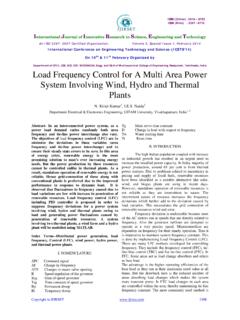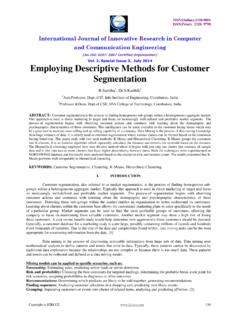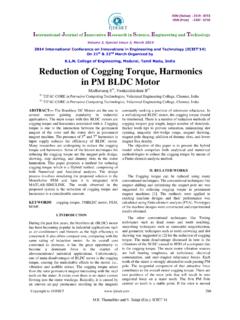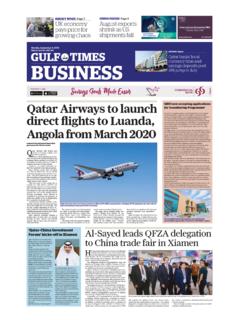Transcription of Research Reviews: ournal of Dental Sciences - rroij.com
1 E-ISSN:2320-7949. p-ISSN:2322-0090. Research & Reviews: Journal of Dental Sciences Perception to Altered Smile Features of Saudi Dental Students at Different Academic Levels Nabeel F. Talic1*, Azam A. AlDuwaile2, Hamad A. AlHazmi3, Rashad R. Tashkandi2, Abdullah S Mokeem4, Adeem S AlOfi5. 1. Associate Professor and Consultant Orthodontist, Department of Pediatrics, Dentistry and Orthodontics, College of Dentistry, King Saud University, Riyadh, Saudi Arabia 2. General Dentist, Dental services, King Abdulaziz Medical City, Ministry of National Guard-Health Affairs, Riyadh, Saudi Arabia 3. Resident Dentist, Ministry of Health, Saudi Arabia 4. General Dentist, Private Practice, Saudi Arabia 5. Teaching Assistant, Department of Preventive Dentistry, College of dentistry, King Saud bin Abdulaziz University for Health Sciences , Riyadh, Saudi Arabia Research Article Received date: 24/06/2016 ABSTRACT.
2 Accepted date: 06/08/2016 Purpose/Objectives: The aim of this study was to evaluate the perception of Published date: 13/08/2016 Dental students towards altered smile esthetic parameters and the effect of *For Correspondence abnormal deviations of these parameters. Dr. Nabeel Talic, Department of Pediatric Dentistry Materials and Methods: A sample of 300 Dental students was divided and Orthodontics, College of Dentistry, King Saud by gender into 150 males and 150 females. The sample was further University, Riyadh, Saudi Arabia subdivided based on the academic level from 1st year to 5th year. Twenty- four photographs with altered smile features were used. Altered features E-mail: included gingival show upon smiling (GS), central incisor crown length (CL), Keywords: Perception, Education, Dental , midline shift (MS), and midline diastema (D). The photos were randomly Academic level, Saudi students.
3 Presented to the participants. A form containing the visual analogue scale (VAS) was distributed to the students and used to rate the smile esthetics. Results: Perceptions of Dental students in different academic levels to GS alterations showed that Level 5 denoted a more unattractive rating than level 2 students (p-value< ). There was no significant difference between levels when the CL discrepancy was mm. In the remaining discrepancies level 4 students was the most critical group. There was a significant difference between levels when the MS was 5 mm (p-value<. ). There was no significant difference among the levels when the D. discrepancy was >0 mm. Conclusions: Students at level four and five have been exposed to undergraduate orthodontic courses in their academic curriculum, which shifts their perception towards being more critical in their evaluation of altered smile features and approximating the general dentists and orthodontists groups.
4 INTRODUCTION. Having pleasant Dental esthetics is a concern of Dental patients and a treatment goal for dentists and orthodontists. The face plays a fundamental role in determining the aesthetic perception of a person during interpersonal communication. Vital contributors to facial beauty are the eyes and mouth [1-3]. Understanding smile attractiveness is vital because aesthetics is the parameter that laypeople use to judge the success of a treatment. [4,5]. Smile analysis is a key in diagnosis and treatment planning [6]. The perception of a smile is different from one person to another and is affected by many factors, such as personal experience and the social JDS | Volume 4 | Issue 3 | September, 2016 136. e-ISSN:2320-7949. p-ISSN:2322-0090. environment [7]. One should understand that the standards of beauty are constantly changing with time, culture, and education [4,5].
5 A smile is influenced by many factors and parameters, such as tooth color and shape, Dental midline shift, midline diastema, gingival display upon smiling, and crown length. These factors play an essential role in the dynamics of a smile, resulting in the perception and judgment of whether the smile is considered attractive or not attractive. An ideal smile might be considered a myth, but the objective of achieving an attractive smile is through a harmonious balance [7,8]. Facial and Dental midline coordina- tion are vital in the establishment of facial harmony and balance [9]. However, precise alignment of the facial and Dental midline is difficult to achieve, and a midline discrepancy of less than 2 mm is considered acceptable [10,11]. An area of concern for most specialists is gingival display upon smiling, or in other words, a gummy smile. Orthodontists and surgeons tend to see gummy smiles as unattractive.
6 A smile that demonstrates minimal gingival display is considered to be more attractive than a smile with excessive gingival display [12]. Kokich et al. concluded that gingival display is only considered unattractive by lay people if it exceeds 4 mm of display [13]. Concerning the appearance of the central incisors, less than 75% display of the upper incisors is considered unacceptable . Regarding midline diastema, cultural background is highly influential in the perception of smile esthetics. For example, the [13]. Indian population considers a midline diastema of up to 2 mm as acceptable [5]. Asymmetric alterations make the dentition es- thetics undesirable to both clinicians and lay people [14]. It has also been proven that Dental clinicians are more critical concerning smile alterations than lay people [15]. Dental students develop knowledge via the systematic learning process.
7 They are expected to evaluate the patient's smile and to meet their expectations at a certain level [1]. The literature has shown minimal data demonstrating the perception of smile aesthetics among Dental students. Portuguese laypersons, Dental students and Dental professionals had non-significant different perceptions of attractiveness when evaluating modified smile features, except for diastemas [16]. Furthermore, it would be benefi- cial to understand the effect of Dental students learning process on their perception of smile aesthetics. The aim of this study was to evaluate the perception of Dental students towards altered smile esthetic parameters and the effect of abnormal deviations of these parameters. MATERIALS AND METHODS. Sample A sample of 300 Dental students at the College of Dentistry, King Saud University in Riyadh, Saudi Arabia was divided by gender into 150 males and 150 females with an age range of 19-25 years.
8 The sample was further subdivided based on the aca- demic level from 1st year to 5th year (30 students per level). Ethical approval was obtained from the College of Dentistry Research Center (CDRC) prior to the start of the Research ; the participants in the study signed an informed consent. Subjects were randomly selected from each level using the Research Randomizer. Variables Twenty-four photographs with altered smile features were used. Photos were cropped to eliminate other facial features to minimize its influence. Smile features were altered using Adobe Photoshop Software (Adobe Systems incorporated, San Jose, California). Altered features included gingival show upon smiling (GS), central incisor crown length (CL), midline shift (MS), and midline diastema (D). The photos were randomly presented to the participants as slides using Microsoft PowerPoint Software. Each picture was shown for ten seconds, and the participants could not return to the previous image once it had changed.
9 The study was performed in a classroom for every level independently (ten students each time) to ensure clear vision for each par- ticipant. The time of the study was fixed at 12:00 pm to minimize variations in the students' concentration levels. Alterations in the smile features were as follows Gingival show: Gingiva to lip margin level (gingival show) was increased by 1 mm increments to create a gummy smile. Alterations were based on the relationship of the upper lip with the gingival margin of the maxillary incisors (Figure 1). Figure 1: Photographs showing alteration to the vertical height of the ginigival margins of the maxillary lateral incisors in relation to the gingival height of the central incisors. (A) No alteration; (B) 1 mm alteration; (C) 2 mm; (D) 3 mm; (E) 4 mm and (F) 5 mm. JDS | Volume 4 | Issue 3 | September, 2016 137. e-ISSN:2320-7949. p-ISSN:2322-0090.
10 Crown length: The crown length of the maxillary central incisors was altered by mm increments. The alteration was made to the maxil- lary central incisors using the incisal edge as a reference point to the highest point of the gingival margin (Figure 2). Figure 2: Photographs showing alteration to the crown length of the central incisors. The alteration was made to the maxillary central incisors, using the incisal edge as a reference point to the highest point of the gingival margin. (A) Central incisor crown length alteration by mm increment; (B) 1 mm increment; (C) mm increment; (D) 2 mm increment; (E) mm and (F) 3 mm increment. Midline shift: The Dental midline shift was made on the maxillary segment, while the lower midline and lip cupid bow were fixed and used as a reference. A 1 mm incremental alteration was performed to shift the upper midline to the left (Figure 3).












